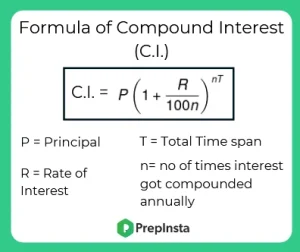Quants Menu
- HCF and LCM
- Number System
- Number Decimals & Fractions
- Surds and Indices
- Divisibility
- Ages
- LCM
- HCF
- Inverse
- Speed Time and Distance
- Work and Time
- Boats and Streams
- Pipes and Cisterns
- Averages
- Allegations and Mixtures
- Ratio and Proportions
- Simple & Compound Interest
- Simple Interest
- Compound Interest
- Percentages
- Profit & Loss
- Successive Discount 1
- Successive Discount 2
- AP GP HP
- Arithmetic Progressions
- Geometric Progressions
- Harmonic Progressions
- Probability
- Permutation & Combination
- Combination
- Circular Permutation
- Geometry
- Heights and Distances
- Perimeter Area and Volume
- Coordinate Geometry
- Venn Diagrams
- Set Theory
- Algebra
- Linear Equations
- Quadratic Equations
- Logarithms
- Clocks
- Calendars
- Clocks and Calendars
- Finding remainder of large powers
PREPINSTA PRIME
Compound Interest Formulas
Compound Interest Formulas in Aptitude
On this page we have discussed Compound Interest formulas, definition with examples.
Compound Interest in Maths
Compound interest is a concept in mathematics and finance that refers to the interest earned or paid on an initial amount of money, called the principal, as well as any accumulated interest from previous periods. Unlike simple interest, where interest is only calculated based on the initial principal, compound interest takes into account both the initial amount and the interest earned over time.

Compound Interest Formula
- Compound interest is the interest calculated on the original principal and on the accumulated past interest of a deposit or loan. Compound interest is calculated based on the principal, interest rate (APR or annual percentage rate), and the time involved.
Formula of Compund Interest (CI) = P (1+ \mathbf{\frac{r}{100n}})^{nT} – P
Formula of Amount = CI +P
= P (1+ \mathbf{\frac{r}{100n}})^{nT} – P + P
Here, P = Principal
r = rate of interest
T = the number of years the amount is deposited or borrowed for.
n= the number of times that interest is compounded per unit ‘t’.

| Times(in years) | Amount | Interest |
|---|---|---|
| 1 | P\left ( 1-\frac{R}{100} \right ) | \frac{PR}{100} |
| 2 | P\left ( 1-\frac{R}{100} \right )^2 | P\left ( 1-\frac{R}{100} \right )^2-P |
| 3 | P\left ( 1-\frac{R}{100} \right )^3 | P\left ( 1-\frac{R}{100} \right )^3-P |
| 4 | P\left ( 1-\frac{R}{100} \right )^4 | P\left ( 1-\frac{R}{100} \right )^4-P |
| n | P\left ( 1-\frac{R}{100} \right )^n | P\left ( 1-\frac{R}{100} \right )^n-P |
Prime Course Trailer
Related Banners
Get PrepInsta Prime & get Access to all 200+ courses offered by PrepInsta in One Subscription
Important Compound Interest formulas
- Formulas for Compound Interest (When Interest is Compound Annually)
- Amount = P\mathbf{(1+ \frac{r}{100})^{T}}
- Compound Interest =Total amount – Principal
- Rate of interest (R) = [\mathbf{(\frac{A}{P})^{\frac{1}{T}}}− 1]%
- Formulas of Compound Interest (When Interest is Compound Half Yearly)
- Amount = P (1+ \mathbf{\frac{{\frac{r}{2}}}{100})^{2T}}
- Compound Interest = Total amount – Principal
- Compound Interest Formulas (When Interest is Compound Quarterly)
- Amount = P (1+ \mathbf{\frac{{\frac{r}{4}}}{100})^{4T}}
- Compound Interest = Total amount – Principal
- Formulas of Compound Interest (When Interest is Compound Monthly)
- Amount = P (1+ \mathbf{\frac{{\frac{r}{12}}}{100})^{12T}}
- Compound Interest Formulas (When Interest is Compounded Annually but time is in fraction, say 2(\mathbf{\frac{3}{2}})years )
- Amount = P (1+ \mathbf{\frac{r}{100}})^{2}(1+ \mathbf{\frac{\frac{3}{2}r}{100}})
- Formulas of Compound Interest (When rates are different for different years)
- Amount = P (1+\frac{r_{1}}{100}) (1+\frac{r_{2}}{100}) (1+\frac{r_{3}}{100})
- Formulas for Compound Interest (Present worth of Rs. x due n years)
- Present worth = \frac{x}{(1+\frac{r}{100})}
Problems Based on Formulas Of Compound interest with solutions
Question 1 . Find the amount on Rs 16000 for 3 year at 5% per annum compounded annually n.
[A] Rs. 18562
[B] Rs. 18550
[C] Rs. 18952
[D] Rs. 18552
Solution : According to the formula of Compound Interest
Amount = P (1+ \mathbf{\frac{r}{100}})^{n}
Amount = 16000 (1+ \mathbf{\frac{5}{100}})^{3}
Amount = 16000 (1+ \mathbf{\frac{1}{20}})^{3}
Amount = 16000 (\mathbf{\frac{21}{20}})^{3}
Amount =18552
Correct Option: D
Question 2 . Find the compound interest on Rs. 10,000 at 20% per annum for 5 years 4 months, compounded annually is :
[A] Rs. 16600
[B] Rs. 16544
[C] Rs. 15644
[D] Rs. 16500
Solution : According to the Formula of Compound Interest ,
CI = P (1+ \mathbf{\frac{r}{100}})^{n} – P
[B] 53800
[C] 18330
[D] 83787
Solution: Using CI formula,
78000( 1 + \frac{10}{100}) = 85800
( 85800 – y ) *( 1 + \frac{10}{100}) = 35200
85800 – y = 32000
y = 53800
Correct Option: 53800
[A] 9
[B] 1
[C] 2
[D] 3
Solution: As C.I for the 1st year = S.I
Interest for 1st year = 73000*\frac{10}{100}
= 7200 Rs
As interest on interest is C.I
Interest for the 2nd year = 7200 + 7200*\frac{10}{100}
= 7200 + 720 = 7920
Interest for the 3rd year = 7920 + 7920\frac{10}{100}
= 7920 + 792 = 8712
Total interest at the end of 3 years = 7200 + 7920 + 8712
= 23832
Therefore t = 3
Correct Option= 3
Question 5 . The Compound Interest on a certain amount at a certain rate of interest, for the 7th and 8th year, was Rs 2180 and Rs 2659.6 respectively. Find the rate of interest per annum.
[A] 3
[B] 12
[C] 22
[D] 28
Solution: Using interest on interest is C.I
Let r be rate of interest
2180 + 21.8r = 2659.6
21.8r = 2659.6 – 2180
r = 22
Also Check Out
Get over 200+ course One Subscription
Courses like AI/ML, Cloud Computing, Ethical Hacking, C, C++, Java, Python, DSA (All Languages), Competitive Coding (All Languages), TCS, Infosys, Wipro, Amazon, DBMS, SQL and others
- Averages – Questions | Formulas | How to Solve Quickly | Tricks & Shortcuts
- Allegations and Mixtures – Questions | Formulas | How to Solve Quickly | Tricks & Shortcuts
- Ratio and Proportions – Questions | Formulas | How to Solve Quickly | Tricks & Shortcuts
- Simple & Compound Interest – Questions | Formulas | How to Solve Quickly | Tricks & Shortcuts
- Simple Interest – Questions | Formulas | How to Solve Quickly | Tricks & Shortcuts
- Percentages – Questions | Formulas | How to Solve Quickly | Tricks & Shortcuts
- Profit & Loss – Questions | Formulas | How to Solve Quickly | Tricks & Shortcuts
Others
- Allegations and Mixtures – Questions |
Formulas |
How to Solve Quickly |
Tricks & Shortcuts - Ratio and Proportions – Questions |
Formulas |
How to Solve Quickly |
Tricks & Shortcuts - Simple & Compound Interest – Questions |
Formulas |
How to Solve Quickly |
Tricks & Shortcuts - Simple Interest – Questions |
Formulas |
How to Solve Quickly |
Tricks & Shortcuts - Averages – Questions |
Formulas |
How to Solve Quickly |
Tricks & Shortcuts - Percentages – Questions |
Formulas |
How to Solve Quickly |
Tricks & Shortcuts - Profit & Loss – Questions |
Formulas |
How to Solve Quickly |
Tricks & Shortcuts
Others

 Apply For Jobs
Apply For Jobs Get Hiring Updates
Get Hiring Updates


Login/Signup to comment